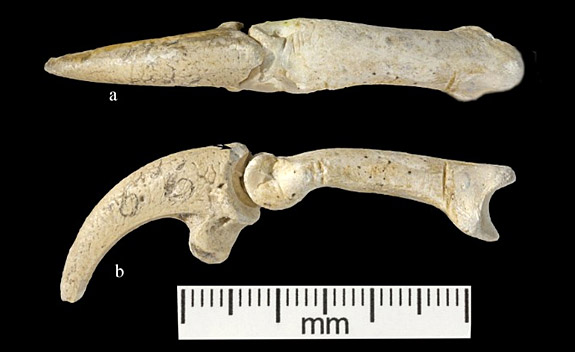March 18th, 2015
Anthropologists at the University of Kansas claim that fashionable Neanderthals wore handcrafted jewelry made from eagle talons 130,000 years ago. The eagle talon adornment, shown here, could very well be the world's oldest jewelry.

A new study published in the journal PLOS ONE suggests that the Neanderthals who predated modern humans were much more intelligent and style-conscious than previously believed.
Study author David Frayer, an anthropology professor at the University of Kansas, based this assumption on a collection of eight white-tailed eagle talons that were excavated 100 years ago from a cave in present-day Croatia.

At the time of the find, the talons didn’t seem to be unusual, but on further inspection, it was determined that the talons had notches and tool marks on them, indicating that they were strung together either as a necklace or bracelet.
"It really is absolutely stunning," Frayer told Live Science. "It fits in with this general picture that's emerging that Neanderthals were much more modern in their behavior."

The talons were just a few of the thousands of items extracted from a cave between 1899 and 1905 by Croatian scientist Dragutin Gorjanovic-Kramberger. Although the original find yielded valuable information about Neanderthals, the tooling that allowed the talons to be used for body ornamentation was discovered only recently.
"I was stunned," Frayer told CNN. "It's so obvious that these are cut."
Frayer and the co-authors of "Evidence for Neanderthal Jewelry: Modified White-tailed Eagle Claws at Krapina" surmised that the Neanderthals were also catching the eagles, whose talons they harvested for jewelry.
Even today, catching an eagle is no easy feat, so the anthropologists believe the Neanderthals must have developed excellent “planning skills and ritual” to pull off such a formidable challenge.
"Neanderthals are often thought of to be simple-minded mumbling, bumbling, stumbling fools," Frayer told CNN. "But the more we know about them the more sophisticated they've become."
Scientists believe that Neanderthals appeared in Eurasia between 200,000 and 250,000 years ago and died out about 40,000 years ago.
The model of an adult Neanderthal male (shown above) is on display in the Hall of Human Origins in the Smithsonian Museum of Natural History in Washington, D.C.
Credits: Talon jewelry: Luka Mjeda. Neanderthal: By reconstruction: John Gurche; photograph: Tim Evanson CC BY-SA 2.0, via Wikimedia Commons.

A new study published in the journal PLOS ONE suggests that the Neanderthals who predated modern humans were much more intelligent and style-conscious than previously believed.
Study author David Frayer, an anthropology professor at the University of Kansas, based this assumption on a collection of eight white-tailed eagle talons that were excavated 100 years ago from a cave in present-day Croatia.

At the time of the find, the talons didn’t seem to be unusual, but on further inspection, it was determined that the talons had notches and tool marks on them, indicating that they were strung together either as a necklace or bracelet.
"It really is absolutely stunning," Frayer told Live Science. "It fits in with this general picture that's emerging that Neanderthals were much more modern in their behavior."

The talons were just a few of the thousands of items extracted from a cave between 1899 and 1905 by Croatian scientist Dragutin Gorjanovic-Kramberger. Although the original find yielded valuable information about Neanderthals, the tooling that allowed the talons to be used for body ornamentation was discovered only recently.
"I was stunned," Frayer told CNN. "It's so obvious that these are cut."
Frayer and the co-authors of "Evidence for Neanderthal Jewelry: Modified White-tailed Eagle Claws at Krapina" surmised that the Neanderthals were also catching the eagles, whose talons they harvested for jewelry.
Even today, catching an eagle is no easy feat, so the anthropologists believe the Neanderthals must have developed excellent “planning skills and ritual” to pull off such a formidable challenge.
"Neanderthals are often thought of to be simple-minded mumbling, bumbling, stumbling fools," Frayer told CNN. "But the more we know about them the more sophisticated they've become."
Scientists believe that Neanderthals appeared in Eurasia between 200,000 and 250,000 years ago and died out about 40,000 years ago.
The model of an adult Neanderthal male (shown above) is on display in the Hall of Human Origins in the Smithsonian Museum of Natural History in Washington, D.C.
Credits: Talon jewelry: Luka Mjeda. Neanderthal: By reconstruction: John Gurche; photograph: Tim Evanson CC BY-SA 2.0, via Wikimedia Commons.


